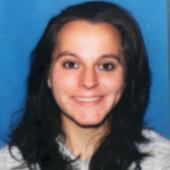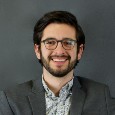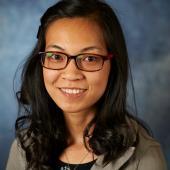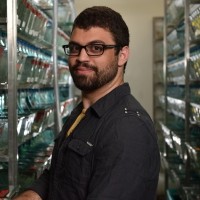Ernesto Bedoy

The overall goal is to characterize changes in stimulation-evoked muscle recruitment in the upper-limb after stroke and in the lower-limb after amputation and determine how these changes relate to hand function and phantom limb pain, respectively. Mentor: Douglas Weber, PhD
Michael Behrens

The goal of the study is to create electromechanical control systems for biohybrid microhelical swimming robots that can be hybridized with drugs or living cellular therapies to develop new drug delivery models. The goal is to deploy these in the cerebrospinal fluid to enable drug delivery in situ in diseased tissue where systemically delivered pharmaceuticals may not penetrate. Thus, this tool will have the potential to transform pharmaceutical interventions for a range of neurological diseases. Mentor: Warren Ruder, PhD
Michelle Drewry

The goal is to evaluate the effect of substrate topography on the bioactivity of dental pulp cell (DPC) constructs in vitro. Another focus is to also evaluate the regenerative effect of inducing Schwann cell differentiation in DPC sheets in vitro. And the final goal is to evaluate the ability of the scaffold-free DPC nerve conduits to promote regeneration in a rat facial nerve defect. Mentor: Fatima Syed-Picard, PhD
George Gabriel

One goal of the study is to elucidate how Sap130 deficiency causes HLHS associated defects in forebrain development through cortical plate formation studies and RNAseq transcriptome profiling, Sap130 ChIPseq analysis, and DNA methylation analysis of both Ohia and Emx1-cre deleted Sap130 animals. Second goal is to characterize brain defects and functional deficits associated with Sap130 deficiency via multi-modal structural magnetic resonance imaging (MRI) in conjunction with neurobehavioral tests in adult Emx1-cre deleted Sap130 animals. Final goal is to determine if Sap130 deficiency is sufficient to impair brain development in humans we will analyze growth of cerebral organoids derived from Sap130 deficient human embryonic stem cells. Mentor: Cecilia Lo, PhD
Martin Haschak

The goal of the study is to develop an in vitro model to better assess the contributions of tissue biomechanics and compositions as predictors of naïve bone marrow-derived macrophage phenotype and function. Additional goal is to develop an in vivo model to assess the contribution of pre-mature ventricular stiffening as a mechanism underlying the observed altered regulation of the cardiac tissue resident macrophage compartment which occurs with increasing age. Mentor: Bryan Brown, PhD
Shea Heilman

Tet2-/- ;tet3-/- zebrafish showed loss of 5hmC, and impaired differentiation of several retinal cell populations likely via cell- intrinsic (neuron-intrinsic) and cell-extrinsic (microenvironmental) alterations. Our goal is to identify the cellular and lineage composition of tet2-/- ;tet3-/- versus sibling control retinas. Also, to identify differentiation-inhibitory cell populations present during tet2-/- ;tet3-/- retinal development. The final goal is to identify gene expression events associated with impaired terminal differentiation in tet2-/- ;tet3-/- retinal development. Mentor: Jeffrey Gross, PhD
Joshua Hislop

The focus is to develop synthetic endoderm as a substrate for organ development. This is via characterize of the effect of GATA6 gene circuit dosage on the development of multiple cell fates within the organoid system. And by demonstrating the applicability of GATA6 gene circuit dosage to advance maturity of endoderm organoids in vitro. The second focus is to create and validate gene circuits for programming neural and liver fates together in iPSCs. This will be done by developing small-molecule promoters that can be used to drive engineered gene expression within mammalian cell lines. This will also be done by engineering a cell line with genetic circuits responsive to separate small molecules showing independent activation by each respective inducer. Finally, the goal will be to apply multiplex gene circuits to drive the specification of a neural subpopulation to achieve innervation of the liver organoid system. Mentor: Mo Ebrahimkhani, MD
Karis Kosar

The focus of the study is to examine the effect of canonical Wnt signaling on hepatocyte transdifferentiation and noncanonical Wnt signaling on cholangiocyte proliferation to promote the repair of injured bile ducts and production of healthy bile ducts in models of primary sclerosing cholangitis. Mentor: Kari Nejak-Bowen, MBA, PhD
Ryan LeGraw

Ex vivo expansion of hematopoietic stem cells (HSCs) is of immense clinical interest for therapeutic use but has not been achieved effectively. Since hematopoietic stem cells expand in the fetal liver, a fetal liver organoid based on a GATA6 inducible iPSC line, could be used as a unique niche for ex vivo HSC expansion and be further genetically engineered for customizable applications. Thus, the focus of the study is to Characterize the capacity for fetal liver organoids to expand HSCs ex vivo. And to develop and test genetic engineering pipeline for fetal liver organoids to generate customizable niche. Mentor: Mo Ebrahimkhani, MD
Margaret Macknick-Champion

Before messenger RNA can be used to create proteins, it must be edited into a mature form that contains only sequences that code for a protein product (called introns). The process of editing can result in multiple mRNA products from a single gene, allowing for the generation of diverse protein isoforms. The fidelity of this process can decline with age, and multiple lines of evidence link age-related decline in the fidelity of mRNA splicing to age-related reproductive decline. However, the role of splicing in reproductive aging is poorly understood. Using genomic and engineering approaches, my project examines the role of alternative splicing in the process of reproductive aging. Age related reproductive decline is a complex process that is interlinked with decline in many somatic processes. The insights gained from my project may lead to a better understanding of the basis of age-related decline, as well as to interventions that ameliorae age-related reproductive decline. Mentor: Arjumand Ghazi, PhD
Joseph Maggiore

Current efforts in drug discovery and understanding disease pathways fall short due to a lack of representative in vitro model that recapitulates organ physiology. The focus of this work aims to generate highly vascularized human kidney organoids in order to understand kidney physiology and acute kidney injury. Mentors: Neil Hukriede, PhD and Sunder Sims-Lucas, PhD
Meagan Makarczyk

The goal of this study is to develop an artificial gene circuit to restore mitophagy in aged chondrocytes through a p21 responsive gene synthetic promoter. Through these engineering techniques we hope “rejuvenate” aged chondrocytes for enhanced cartilage regeneration in aged individuals (45 years and older). Mentor: Hang Lin, PhD
Nicole Martucci

The extracellular matrix (ECM) is important for survival, differentiation, and normal functioning of cells within the liver; integrins are key signaling receptors in this process. Previous data from our lab has shown that with hepatocyte specific knockout of integrin linked kinase (hILK KO), there is hepatocyte proliferation, increased matrix deposition, unorganized biliary cell/ductal proliferation, and possible transdifferentiation of hepatocytes to cholangiocytes; this led us to investigate the signaling pathways downstream of hILK KO that might be responsible for the observed phenotype, and we uncovered a potential central role for Phosphoinositide 3-kinase (PI3K) delta (PIK3CD), a variant of PI3K that is considered to be leukocyte specific. I have since been able to link expression of PIK3CD to enhanced proliferation of hepatocytes (using PHx) and potentially slower transdifferention to cholangiocytes (using roller bottles). When inhibiting PIK3CD in the roller bottles, I found the hepatocytes transdifferentiated to cholangiocytes a week earlier than the control. Mentor: George Michalopoulos, MD, PhD
Laura Molina

One focus is to elucidate role of YAP1 and beta-catenin in hepatoblastoma pathogenesis. Another goal is to identify role of YAP1 in embryonic liver development by characterizing 3D structural defects in biliary morphogenesis resulting from loss of Yap1 in hepatoblasts. Final goal is to Identify unique and distinct roles of YAP1 and TAZ in embryonic liver development. Mentor: Paul Monga, MD
Meghan Mooring

The goal of the study is Cyr61 is to investigate YAP activity increases liver injury and mediates fibrosis and inflammation through Cyr61. Another goal is to address if Cyr61 modulates fibrosis and immune cell infiltration in NASH liver injury. Final goal is to block Cyr61 activity (anti-Cyr61 antibody) and see if it can decrease fibrosis and inflammation in liver injury. Mentor: Dean Yimlamai, MD, PhD
Alexis Nolfi

One goal of the study was to attempt to delay IL-4 release from the surface of polypropylene mesh. Another goal was towards in-vivo tracking of IL-4 release from the mesh surface. Using LICOR products (IRDye 800CW NHS ester dye and corresponding equipment, LICOR Odyssey CLx imaging platform), the visualization was successful. Final goal was to establish two different flow cytometry panels (general overview immunology panel and macrophage comprehensive panel), to assess mesh implantations and implantations of biologically derived ECM scaffolds. Another focus has been to release immune modifying cytokines from the surface of soft contact lenses to treat dry eye disease. Mentor: Bryan Brown, PhD
Matthew Poskus

Stromal fibroblasts are a prominent player in the tumor microenvironment. In HER2-positive breast cancer, fibroblasts have been shown to protect tumor cells from HER2-targeted therapies through unknown mechanisms. The goal is to use ER+ MCF-7 expressing fluorescent FOXO1 and ERK to monitor the dynamics of the PI3K and ERK pathway activation and coculture with fibroblasts to study 1) how fibroblasts modulate measure drug sensitivity in ER+ cell lines and 2) how coculture modules PI3K and ERK pathway dynamics. Mathematical models will be built to optimize a therapy to overcome this fibroblast-mediated drug resistance. Mentor: Ioannis Zervantonakis, PhD
Kien Tran

One focus is to examine if long-term cryopreservation and/or gonadotoxic treatments affect functions of germ cells in pre-pubertal testicular tissues of cancer patients. Another goal is to develop cell-based therapy for cryo-preserved testicular tissues to restore fertility for childhood cancer survivors. Another goal is to develop tissue-based therapy for cryo-preserved immature testicular tissues: In vitro development of frozen-and-thawed testicular tissues of rodents and primates. Final goal is fertility restoration for male patients carrying fertility-associated genetic defects by utilizing gene editing in induced pluripotent stem cells (iPSCs) derived from an infertile mouse model – generated from a human fertility- associated gene mutation – followed by in vitro differentiation of gene- corrected iPSCs into the germline linage. Mentor: Kyle Orwig, MD
Sierra Wilson

The overall goal is to understand the role of aneuploid and polyploid hepatocytes. Emerging data suggests that ploidy populations contribute to liver adaptation and regeneration in an injury-specific manner. Both chronic and acute liver injury models are in use to study the adaptive and regenerative roles of aneuploid and polyploid hepatocytes. Mentor: Andy Duncan
Daniel Zuppo

Overall focus is better understanding of the role of foxm1 in zebrafish cardiomyocyte proliferation after cardiac injury in adult fish. One focus is to characterize the foxm1 mutant phenotype to discern if cardiac regeneration and cardiomyocyte proliferation are impaired. Second goal is to identify any upstream mechanisms that might affect foxm1 expression in cardiomyocytes. Final goal is to identify which of its downstream targets are inactive in the foxm1 mutant and characterize if the specific loss of these targets also impairs cardiomyocyte proliferation and cardiac regeneration using mutant lines against these genes. Mentor: Michael Tsang, PhD
